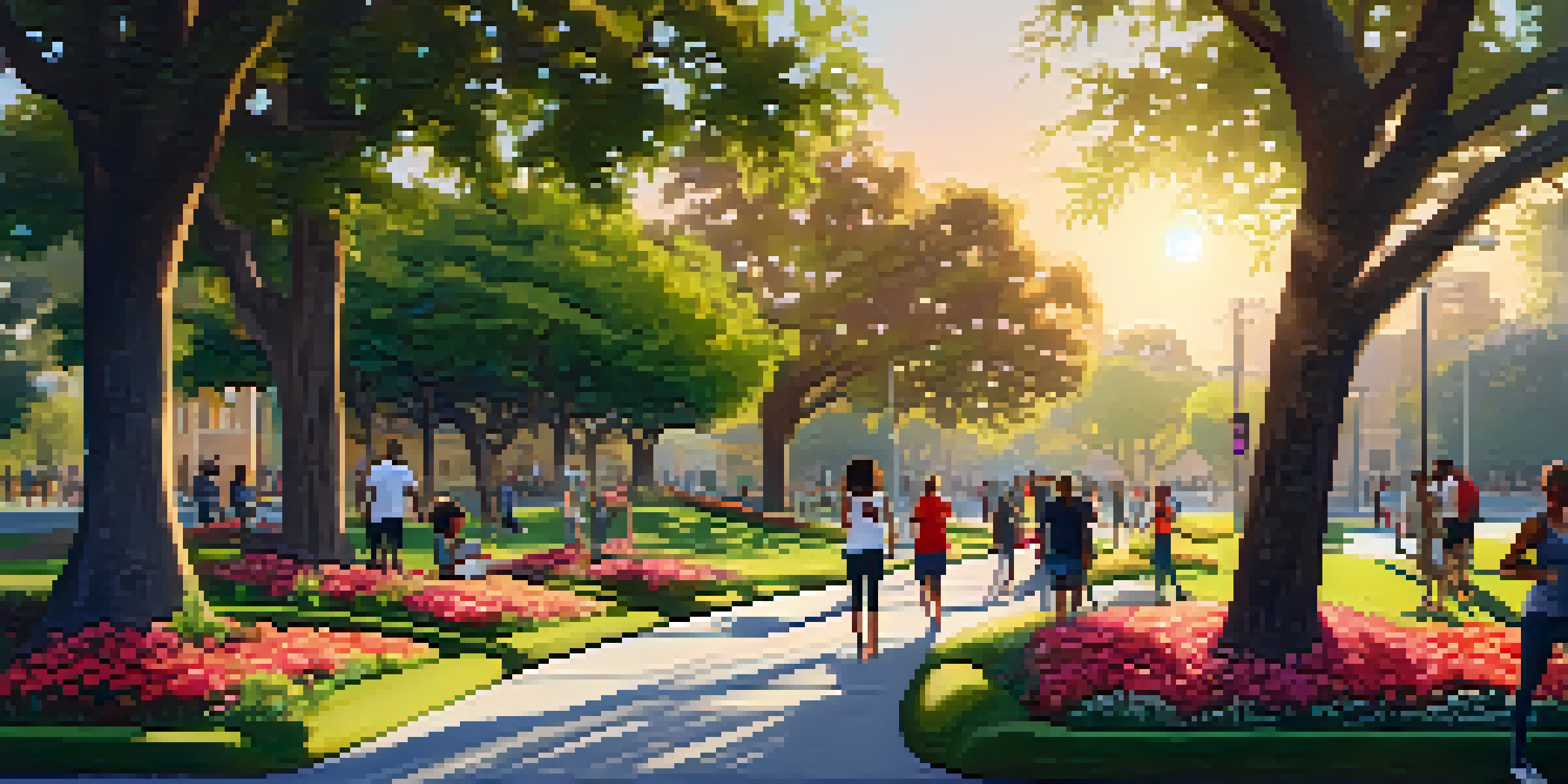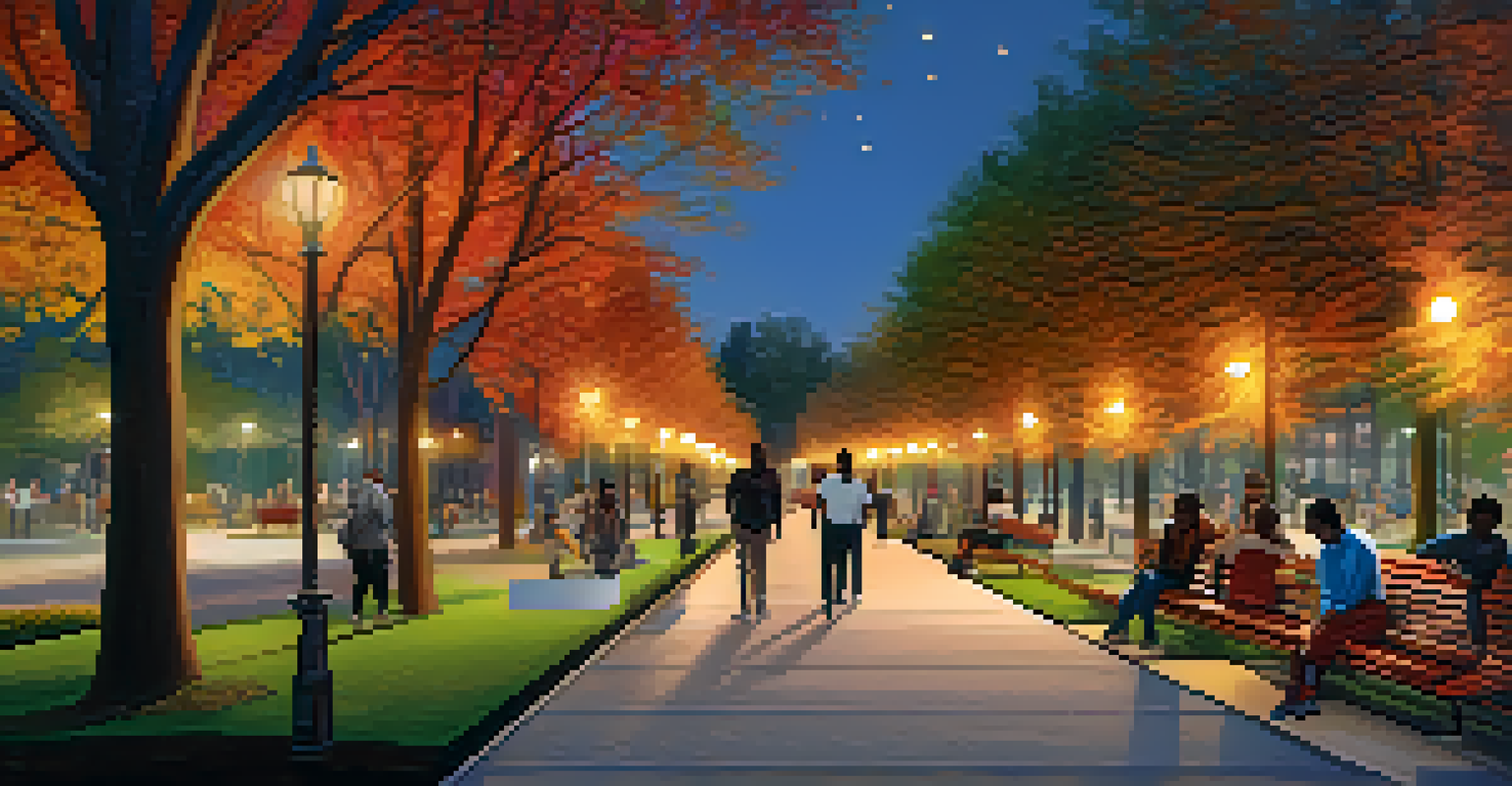Public Spaces and Mental Health: A Compton Perspective

Understanding the Link Between Public Spaces and Mental Health
Public spaces, such as parks and community centers, play an essential role in our mental well-being. They offer a place for social interaction, exercise, and relaxation, which are crucial for reducing stress and anxiety. In Compton, where community ties are strong, these areas can significantly influence how individuals cope with daily challenges.
Parks and public spaces are essential to our mental health, providing a sanctuary where we can unwind and connect with others.
Research shows that spending time outdoors can lower cortisol levels, a hormone linked to stress. This is particularly relevant in urban settings like Compton, where individuals may experience heightened levels of anxiety due to various factors, including economic pressures and social issues. Access to green spaces can provide a natural remedy to these stressors.
Moreover, public spaces serve as venues for community events and gatherings. These activities foster a sense of belonging and connection, which are vital for mental health. When people come together in these spaces, they can share experiences and support one another, creating a more resilient community.
The Role of Parks in Compton's Mental Health Landscape
In Compton, parks are more than just patches of green; they are lifelines for residents seeking mental reprieve. The city’s parks offer a refuge from the hustle and bustle of daily life, allowing individuals to unwind and recharge. This is especially important for those who may not have access to private outdoor spaces.

For example, parks like the Compton Creek Natural Park provide not only a scenic environment but also opportunities for physical activity. Engaging in exercise, whether through walking, jogging, or organized sports, releases endorphins that boost mood and alleviate feelings of depression. These physical benefits are intertwined with the mental health advantages of simply being in nature.
Public Spaces Boost Mental Health
Access to parks and community centers fosters social interaction and relaxation, essential for reducing stress and anxiety.
Additionally, parks often host wellness programs and community workshops that focus on mental well-being. These initiatives can educate residents on coping strategies and resources available for mental health support, fostering a culture of openness and understanding within the community.
Community Centers: A Hub for Mental Wellness in Compton
Community centers in Compton function as vital resources for mental health support and engagement. They offer a range of programs, from counseling services to recreational activities, that cater to various age groups and needs. This accessibility makes it easier for individuals to seek help without stigma.
The design of our urban environments greatly influences our emotional well-being and sense of community.
Programs at these centers often include group therapy sessions, art classes, and support groups, which create safe spaces for sharing experiences. By interacting with others facing similar challenges, individuals can develop coping strategies and build a support network, which is crucial for mental health.
Moreover, community centers frequently collaborate with mental health professionals to provide educational workshops. These initiatives help demystify mental health issues and empower residents with knowledge, making it easier for them to seek help when needed.
Challenges Faced in Accessing Public Spaces
Despite the benefits, many residents in Compton encounter barriers to accessing public spaces. Issues such as transportation, safety concerns, and inadequate facilities can deter individuals from utilizing parks and community centers. These limitations can exacerbate feelings of isolation and stress for those who are already struggling.
For instance, individuals without reliable transportation may find it difficult to reach parks or community centers, particularly if they are located far from their homes. This lack of access can prevent them from experiencing the mental health benefits that these spaces provide.
Parks as Mental Health Lifelines
In Compton, parks provide vital opportunities for exercise and community engagement, enhancing overall mental well-being.
Additionally, safety concerns can significantly impact how often residents choose to visit public spaces. If individuals feel unsafe or uncomfortable, they are less likely to engage with their community, which can lead to increased feelings of loneliness and mental distress.
The Impact of Urban Design on Mental Health
Urban design plays a crucial role in shaping the mental health outcomes of a community. In Compton, thoughtful design of public spaces can enhance accessibility and promote well-being. Features like well-lit pathways, inviting seating areas, and engaging landscaping can encourage more residents to utilize these spaces.
For example, incorporating art installations or community gardens can create a sense of ownership and pride among residents. When people feel connected to their environment, they are more likely to spend time outdoors and engage with others, positively impacting their mental health.
Furthermore, urban planners can prioritize green infrastructure, such as trees and plants, which contribute to cleaner air and a more serene atmosphere. This connection to nature has been shown to lower stress levels and improve overall mental well-being, making it essential for urban areas like Compton.
Promoting Inclusivity in Public Spaces
Inclusivity in public spaces is paramount for fostering mental health in Compton. Ensuring that all residents, regardless of age, ability, or background, can access and enjoy these areas is crucial. This can be achieved through thoughtful design and programming that considers the diverse needs of the community.
For instance, creating wheelchair-accessible paths, providing sensory-friendly areas, and offering programs in multiple languages can make public spaces more welcoming for everyone. When individuals feel seen and valued, they are more likely to participate in community activities that promote mental well-being.
Challenges in Accessing Spaces
Barriers like transportation and safety concerns hinder many residents from utilizing public spaces, exacerbating feelings of isolation.
Additionally, engaging residents in the planning process can lead to more inclusive public spaces. Community input can help identify the specific needs and desires of residents, ensuring that these areas truly reflect the community's values and promote mental health for all.
Looking Ahead: The Future of Public Spaces and Mental Health
As Compton continues to evolve, the future of public spaces holds great potential for enhancing mental health. By prioritizing mental well-being in urban planning and community initiatives, the city can create environments that nurture connection and resilience. This requires collaboration between city officials, mental health professionals, and residents.
Future developments could focus on expanding access to existing parks and community centers while creating new spaces that cater to diverse needs. Incorporating elements such as wellness trails, meditation gardens, and interactive community art can further enrich the mental health landscape in Compton.

Ultimately, fostering a culture that values mental health in public spaces will require ongoing conversation and commitment. By working together, residents and city leaders can ensure that Compton's public spaces continue to be a source of strength and support for everyone.